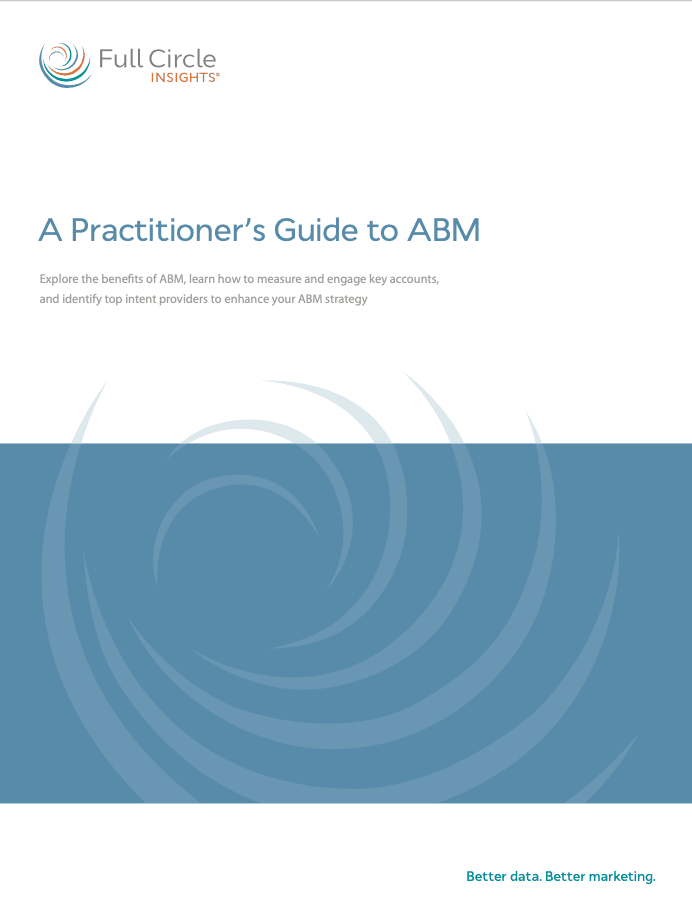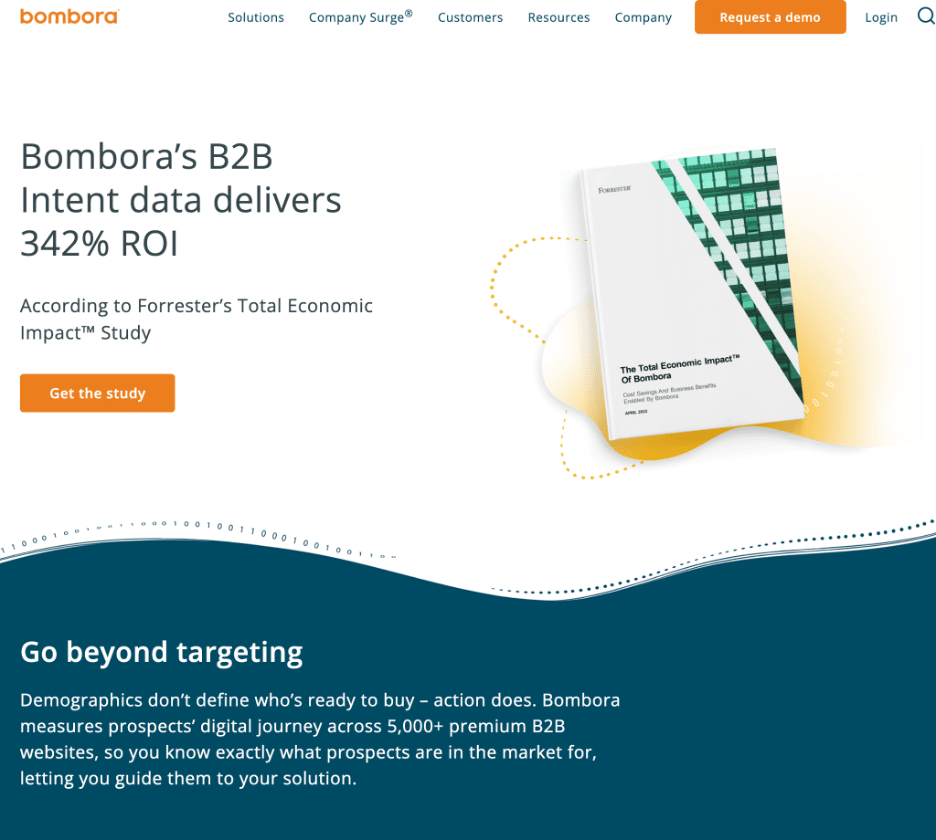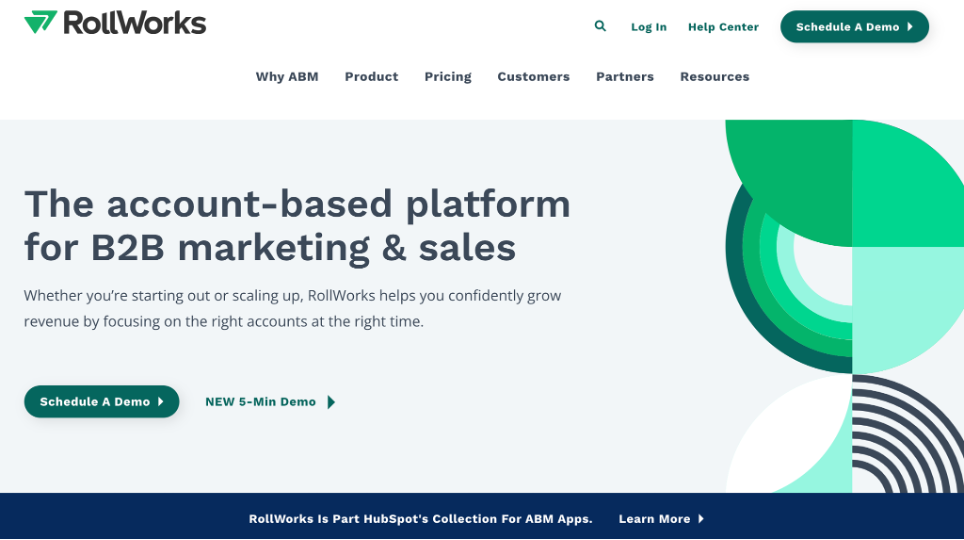Save this eBook for later.
Learn how to measure and engage key accounts, and identify top intent providers to enhance your ABM strategy.
Account Based Marketing, commonly referred to as ABM, has taken the B2B marketing world by storm.
According to HubSpot, 70% of marketers reported using ABM last year, which is a 15% increase from the prior year.
It’s no secret– many B2B companies are using Account Based Marketing (ABM) as a key strategy to target prospects, specifically with the aim of reaching specific accounts that fit an ideal customer profile. That’s because it works. According to a survey conducted by ITSMA, 87% of marketers say that ABM efforts outperform other marketing efforts.
With an influx of interest in creating personalized ABM campaigns, marketers everywhere are looking for help. Not only is it difficult to build a successful ABM strategy and find the right tools for the job, but it’s also essential to constantly measure your efforts to ensure that your ABM campaigns are ultimately driving ROI.
In this guide, we’ll be sharing insights on how to measure your Account Based Marketing efforts. We’ll explain what Account Based Marketing is, review its benefits, share the importance of measurement, and give some tips on how to implement an ABM strategy that engages with more prospects, creates more conversations, and ultimately generates more revenue.
After reading this guide, you’ll learn:
- What is Accoung Based Marketing?
- The benefits of Account Based Marketing?
- Why does measuring Account Based Marketing matter?
- How to implement Account Based Marketing?
- ABM platforms for intent, advertising, and measuring
What is Account-Based Marketing?
Account Based Marketing, often called ABM, is a strategy employed by B2B companies focused on targeting a precise list of high-value accounts. These accounts, which often represent a company or a certain department, are chosen based on certain criteria.
Those using ABM personalize their marketing efforts based on the accounts they want to reach. By personalizing the approach to specific accounts, companies using ABM show their prospects that they understand the challenges they’re facing, which increases engagement and leads to more sales. If you’re just starting out with account-based marketing, check out our blog posts What is Account Based Marketing and How to Get Started with Account Based Marketing for a deeper dive into the landscape of ABM and the steps you can take to implement ABM within your current marketing strategy.
ABM works best when marketing and sales collaborate. By deciding on a set of high-value accounts, the two teams can work together to create a comprehensive strategy. Marketing can create a personalized experience for these accounts based on demographic data and insights from sales, while sales can develop relationships with each account.
The Benefits of Account Based Marketing
ABM has become an incredibly popular way for B2B marketers and sales teams to connect with their prospects. Why is it so popular and successful? What are the benefits of using ABM at your company? Here are the benefits to consider:
Increased ROI from ABM campaigns vs. other marketing efforts
Perhaps the primary reason that companies adopt ABM is because of the potential to increase ROI. After all, all companies have the goal of bettering their marketing and sales strategies to increase revenue. According to research from the ABM Leadership Alliance and ITSMA, 76% of marketers saw higher ROI with ABM than any other marketing strategy.
Better alignment between marketing and sales teams
When a B2B company invests in ABM as a growth strategy, it encourages and requires better alignment between marketing and sales teams. These teams need to work together in order for ABM to be successful. ABM can be a forcing function to help make this happen. Companies using ABM have better-aligned marketing and sales teams than those who don’t.
Personalized campaigns are more likely to reach prospects
Because ABM campaigns focus on target accounts– which have been predetermined– marketers have an opportunity to create personalized campaigns. These campaigns can target a specific company, its challenges, industry, and other pain points. This makes prospects feel as though the company understands their position and is invested in their success.
A seamless customer journey facilitated by a knowledgeable sales team
ABM requires marketing and sales to be in alignment. Aligning sales and marketing is about more than having happy team members– it also leads to a more consistent customer experience. ABM, in particular, helps create a seamless sales process. Because the team is dedicated to a set of target accounts, the sales team has the opportunity to understand prospects so that they can facilitate better conversations.
Why does measuring Account Based Marketing matter?
ABM is an investment. Not only does it take substantial resources to implement new tools and align marketing and sales teams for a new growth strategy, but it can also take a lot of time and effort to generate personalized campaigns for high-value accounts.
Despite the effort, there’s no question that ABM is worthwhile. According to Forrester, sales and marketing teams that work together using an ABM strategy are 6% more likely to exceed revenue goals than teams who are not using ABM. Terminus reported that 86% of marketers believe that ABM improves win rates and 80% say it improves overall customer lifetime value. Not only that but B2B companies with mature ABM strategies credit 79% of opportunities and 73% of total revenue to ABM.
If you’re going to invest in ABM, you need to be sure your efforts lead to success. If you’re not able to measure how engaged target accounts are with your campaigns or attribute sales to ABM efforts, then you’ll simply be in the dark on how you can improve. If the goal is more revenue and a better-performing company, then you need to measure your efforts.
How to implement Account Based Marketing
You need to implement ABM strategically if you’re going to be successful. You’ll need tools that give you visibility. You’ll also need insights into your progress. How can you go about implementing account-based marketing to ensure your strategy is a success?
 Step 1. Assemble your team
Step 1. Assemble your team
ABM strategies are dependent on cross-collaboration between sales and marketing teams. If sales and marketing are pulling in different directions or are even slightly maligned, the customer experience will be inconsistent and ABM campaigns are unlikely to be successful.
For this reason, you should begin your ABM strategy by assembling your team and making sure everyone is in alignment. You should work together to determine an ideal customer profile, build your list of target accounts, and then develop a strategy for how to reach your prospects.
 Step 2. Develop an ABM strategy
Step 2. Develop an ABM strategy
ABM works to engage with prospects and usher them down the funnel, but only if you have goals in mind. These goals should inform your overall strategy so that every member of your team is on the same page.
Some common reasons or goals for developing and executing an ABM strategy include:
- Launching a new product, feature, or service
- Building long-term relationships with strategically selected accounts
- Maximizing revenue
- Personalizing marketing campaigns
When you’re developing a strategy, you’ll need to determine the KPIs you’ll measure along the way to determine your success. You’ll also need to create a timeline that includes the steps you need to take for rolling out the new approach.
Ready to incorporate ABM into your marketing strategy? Check out 5 Ways to Maximize your New Account-Based Marketing Strategy for some helpful tips.
 Step 3: Generate a list of target accounts
Step 3: Generate a list of target accounts
A cornerstone of every successful ABM strategy is a list of target accounts. This list should not be random. Instead, it should be built based on well-established criteria that embody your ideal customer profile.
For example, all accounts on your list may be companies that are larger than 500 employees, use particular software, and have a sales team that’s greater than 20 people.
 Step 4. Create ABM campaigns
Step 4. Create ABM campaigns
Once you’ve assembled your team, developed an overall strategy, and created a list of target accounts, it’s time to create ABM campaigns. In this step, you’ll be putting your ABM strategy into action by using target accounts to create personalized campaigns.
These campaigns may be supported by a number of channels. You can use content marketing (such as ebooks and guides), social media advertising, intelligent chatbots, and email marketing to reach your target accounts.
 Step 5. Track ABM metrics and ABM KPIs
Step 5. Track ABM metrics and ABM KPIs
The only way you’ll know if your ABM program is successful is if you track ABM metrics and KPIs. These metrics might include:
- Pipeline speed—Because ABM is highly targeted, you can close deals faster. Make sure you keep track of target account velocity so you can compare it to speed in a pre-ABM world.
- Activation rates—These tell you how engaged your target accounts are with your campaigns.
- ABM achievement KPIs—Measuring against annual, quarterly, or even monthly targets will keep you on track for your company’s sales goals.
- ABM trending metrics—Metrics such as the number of shares, likes, and comments from target accounts, as well as how many leads are generated from each channel can help you adjust your social media strategy.
- Revenue impact metrics—Tracking your close rates and the impact of campaigns on pipeline and revenue for your target accounts will tell you how well you are doing.
ABM platforms for intent, advertising, and measurement
Implementing an ABM program can be intimidating, but you’re not alone. Thankfully, there are many ABM platforms that can help support your efforts. Today’s platforms help you understand buyer intent, keep track of advertising campaigns, and help you measure the success of your ABM strategy. To help you get started, we’ve compiled a few top ABM platforms worth considering. These platforms will all help ensure that your program is a success.
ABM Intent Platforms
ABM intent platforms allow you to understand what your customers are looking for. Basically, it helps you understand their buying intent so that you can develop campaigns that meet them where they are. Marketers use ABM intent platforms to create campaigns, while sales teams use ABM intent platforms to have more informed conversations.

> 6sense ABM
6sense helps its customers understand anonymous buying behavior and prioritize accounts for sales and marketing so that marketing teams can create personalized ABM campaigns. 6sense customers report that 6sense gives them a competitive edge as they understand what prospects are looking for so they can cater conversations to their interests. Customers also say the platform is very easy to use. Learn more.
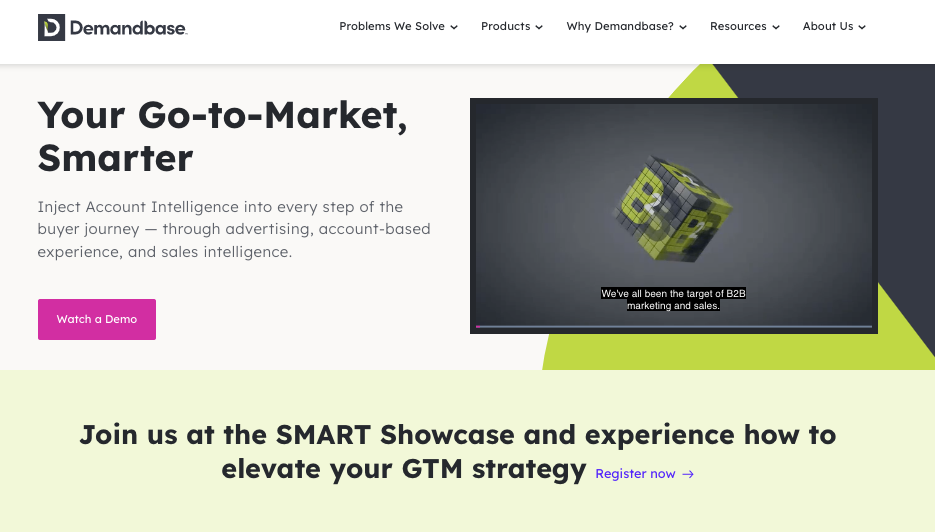
> Demandbase ABM
Demandbase is a comprehensive ABM platform that uses “Account Intelligence” to help sales and marketing teams better orchestrate the B2B buying journey. Customers particularly like Demandbase’s integration with Salesforce, the strong customer service, and the strong database tool. They say it’s easy to use, has a large database of intent keywords, and has particularly good ad targeting performance. Learn more.
> Bombora ABM
Bombora offers a number of solutions that help companies prioritize target accounts. Customers say the platform has a lot of keywords compared to competitors, which is particularly helpful if you’re in a niche industry. Others say it provides “actionable intelligence for ABM” with “a brilliant onboarding and customer success team.” Learn more.
ABM Advertising Platforms
ABM advertising platforms allow you to plan, visualize, and execute advertising campaigns that are targeted to certain accounts. Note that many comprehensive platforms (such as 6sense) include advertising capabilities. The following products are particularly strong when it comes to ABM advertising.
> RollWorks
RollWorks is a comprehensive ABM platform that has a strong advertising product. RollWorks helps you align marketing and sales on target accounts, reach buying committees across channels, and create opportunities faster by providing help with measurement. Learn more.
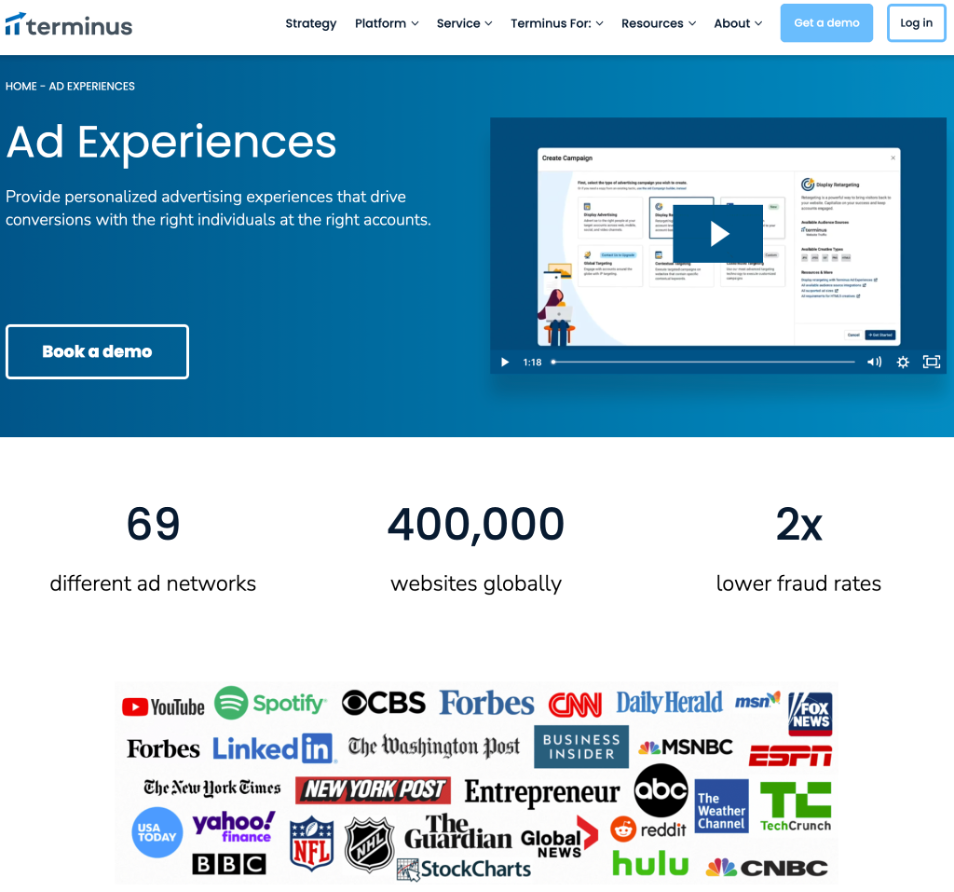
> Terminus
Like RollWorks, Terminus is a comprehensive ABM platform that offers help with multi-channel ABM. In particular, Terminus will help you create personalized advertising experiences that drive conversions. It’s connected with 69 different ad networks, which appear on 400,000 websites globally. Learn more.
ABM Measurement Platforms
No ABM platform is complete without measurement, which is why it’s so important to have a comprehensive solution that helps you own your funnel, defend your marketing spend, and measure your campaigns. For more insight as to how ABM correlates with your ROI, check out How Account-Based Marketing Can Generate ROI.
> Full Circle Insights
Full Circle Insights helps you save time with clear, accurate marketing insights—all within Salesforce. In terms of measurement, it provides a wide variety of metrics so that you can determine which tactics and campaigns drive quantifiable growth. Full Circle Insights provides:
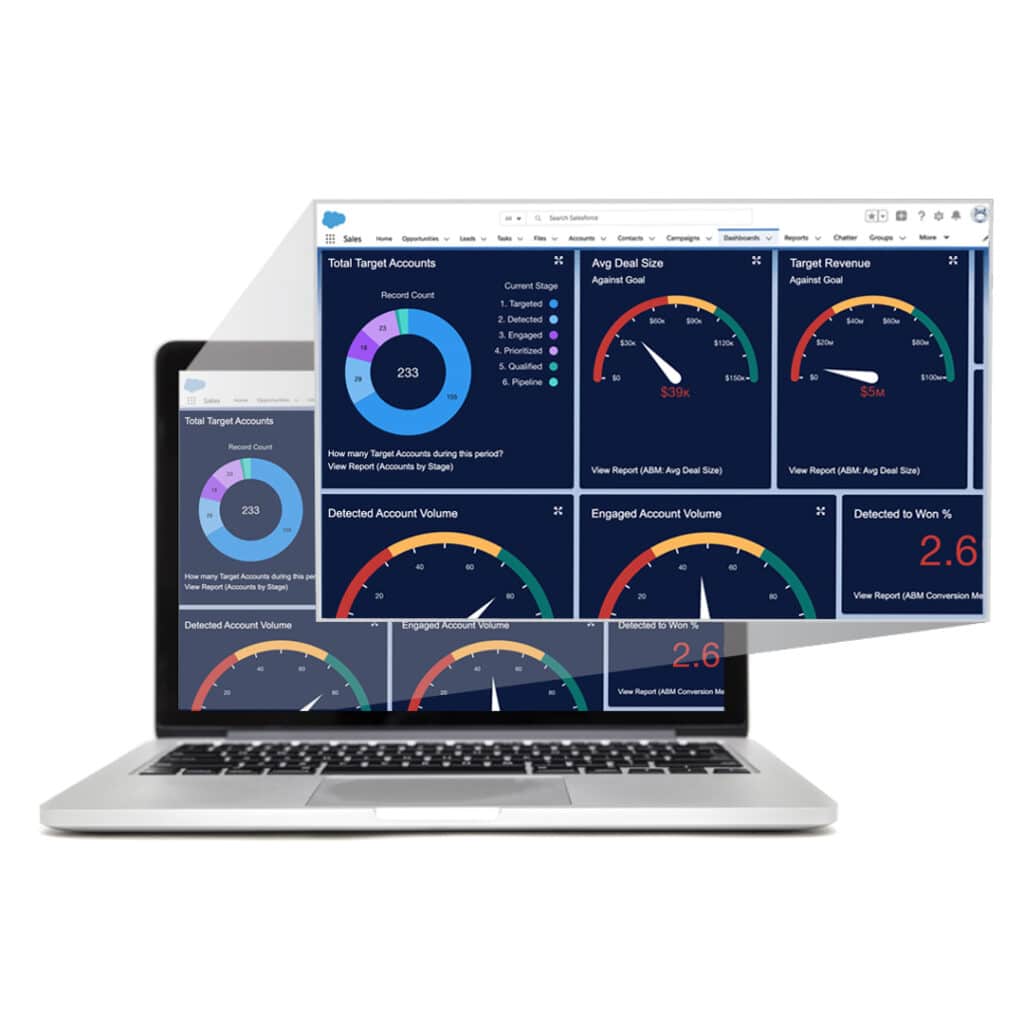 Full Circle ABM —Currently, there is no solution like Full Circle ABM that can combine intent activity for Target Accounts with Response Information that Full Circle provides and provide the ability to report on historical Account Funnel progressions. With Full Circle ABM, these customers will be able to track multiple Account Funnels for their Target Accounts from Detection to Opp Closure and be able to report on the historical volume of Account Funnel Metrics and Progressions. Interested in learning more about Full Circle ABM? Read through, Coming Soon: Full Circle ABM for the inside scoop!
Full Circle ABM —Currently, there is no solution like Full Circle ABM that can combine intent activity for Target Accounts with Response Information that Full Circle provides and provide the ability to report on historical Account Funnel progressions. With Full Circle ABM, these customers will be able to track multiple Account Funnels for their Target Accounts from Detection to Opp Closure and be able to report on the historical volume of Account Funnel Metrics and Progressions. Interested in learning more about Full Circle ABM? Read through, Coming Soon: Full Circle ABM for the inside scoop!
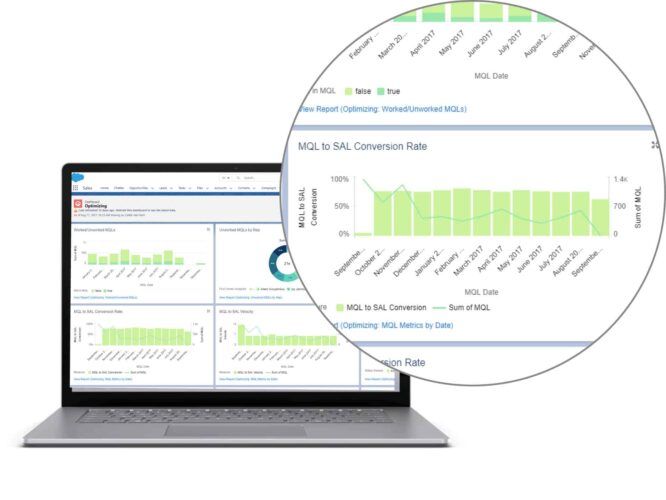
- Funnel Metrics —Track lead progression down the funnel automatically and tie lead responses to revenue. Get accurate, granular sales and marketing Funnel Metrics.
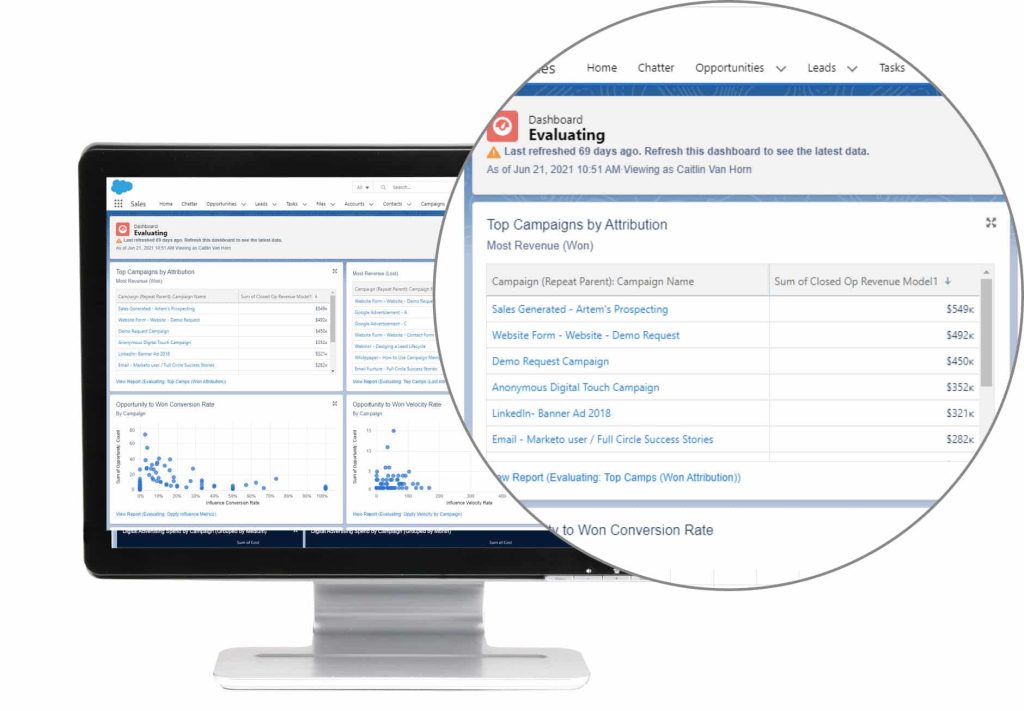
- Campaign Attribution —Evaluate campaign performance and gain insights on every campaign’s impact on revenue and pipeline with Campaign Attribution. Optimize your marketing with confidence.
![]()
- Digital Source Tracker —Measure digital marketing from anonymous first touch to closed-won by connecting anonymous digital touches to known leads in Salesforce with Digital Source Tracker.
Other ABM solutions to explore
We’ve listed many of our favorite tools, but there are plenty of others to explore. Depending on your goals, one of these solutions might be the right fit for you:
- Adobe Marketo Engage
- Apollo.io
- HubSpot Marketing Hub
- Jabmo
- LeadAngel
- LeanData
- Metadata.io
- MRP
- Triblio
- True Influence
- ZoomInfo SalesOS
Conclusion: Build an ABM strategy, then measure your progress
B2B marketers are embracing ABM as they seek to gain more ROI from their campaigns. Sales teams are singing praises of ABM, as well. If you’re considering creating an ABM strategy, now is the time to jump in. Make sure to build a comprehensive strategy with buy-in from your team. Once you begin executing your campaigns, it’s essential to measure as you go. After all, it’s only when you measure that you’ll see your sweeping success.
About Full Circle Insights
Full Circle Insights delivers marketing and sales performance measurement solutions to optimize a company’s marketing mix and drive more revenue. The company offers multi-touch attribution, comprehensive funnel metrics, and lead management technology. Built 100% on the Salesforce Platform, Full Circle Insights products complement leading marketing automation solutions. Founded by former Salesforce executives, CRM implementation veterans, and marketing automation specialists, the Full Circle Insights industry pioneers are seasoned in creating marketing measurement foundations to grow revenue.
Save this eBook for later.
Learn how to measure and engage key accounts, and identify top intent providers to enhance your ABM strategy.
